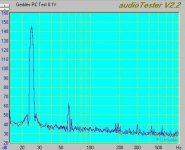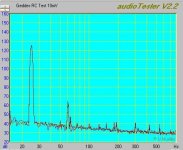gedlee said:This test is documented and done with music signals? Because I have a documented and peer reviewed published study to the contrary.
How was the "pure" 2nd order distortion created? How do you know that there weren't other orders?
Earl,
I can no longer locate the information on the 'test' I'm referring to, so I can't confirm anything about it. I chased it up after I first read about the 'test' done by Carver for Stereo Review in 1973 and the 'critique' of it by Gordon Holt in Stereophile in 1977. I would have located it on the 'net sometime between 1997 and 2000, so it may no longer be there. And, it may conceivably have been as "well documented" as Holts' critique was "un-biased"...
But I'll have a good read of your stuff before I make any more of a fool of myself...
gedlee said:The test used research grade insert earphones which are renown for there low distortion. The tests all used the same equipment in an AB comparison of non-distorted versus distorted music signals. The equipment would make the test uncertain at very low levels of comparison, but certainly not at the levels that we are talking about.
You can criticize the test all you want, but until there is data to the contrary that is perform with the same degree of care, the fact remains that all current data supports what I have said. And, as I have said my results have been corroborated elsewhere, like JBL.
No test is ever proof or perfect, but its foolish to discard the "best" data because you don't like the results. The best data that we have is all in agreement on these points. There is no scientific data to the contrary.
Sorry Earl, I was just playing devils advocate for those that might be alarmed at the knowledge/sight of the research grade headphones flimsy wires (not up to "good" wire standards) or concerned with things like op-amps, NFB, cosmic rays, etc. in the (test) signal path skewing the results.
BTW, could anyone on the test panel set an eq to 0.1db precision by just listening? I wonder if the 25% figure would apply to a person so gifted.
Do you have any plans for a biased cap or active version of the Summa?
cheers,
AJ
AJinFLA said:
Sorry Earl, I was just playing devils advocate for those that might be alarmed at the knowledge/sight of the research grade headphones flimsy wires (not up to "good" wire standards) or concerned with things like op-amps, NFB, cosmic rays, etc. in the (test) signal path skewing the results.
BTW, could anyone on the test panel set an eq to 0.1db precision by just listening? I wonder if the 25% figure would apply to a person so gifted.
Do you have any plans for a biased cap or active version of the Summa?
cheers,
AJ
AJ - at first I took your comments serious, then I figured it out.
The Summas that we have made bi-amped have not worked any better than passive. They can be bi-amped, but I don't see the point. I'll sell them for bi-amping, but I don't recommend it. Getting the right EQ in the active section is difficult.
No Biased caps planned since I don't use elctrolytics. The caps that I use don't have crossover problems.
gedlee, if I combine electrolytic with poly cap (say 10mfd electrolytic and 1mfd poly) , will it still have crossover distortion?
or would you suggest completely avoid electrolytics?
cost savings are not that great.
or would you suggest completely avoid electrolytics?
cost savings are not that great.
MisterTwister said:gedlee, if I combine electrolytic with poly cap (say 10mfd electrolytic and 1mfd poly) , will it still have crossover distortion?
or would you suggest completely avoid electrolytics?
cost savings are not that great.
The whole cap thing is kind of unknown to me. I know that there is a potential for distortion in the caps of a kind that is quite insidious, so I just avoid electrolytics and opt for the more "pure" form of film.
However, if the measurements being done show that there really isn't significant crossover distortion in the electrolytics then I will certainly go with them for some of my larger more expensive caps. For the smaller ones theres no point since the savings is not large enough.
Earl, I played around with your suggested test today. I only had one cap that I could use in the current setup, a 1uF bipolar Radio Shack Bubble Pack Special because of the frequency restrictions.
For the first test, I drove it with about half a volt through a 1k resistor. Signal source was the output of an M-Audio 192 set for 48kHz/24 bit buffered by a BUF03. Test frequency was 25 Hz.
Using my rusty/trusty HP333A, I measured THD. It was below the point where I trust this instrument (0.001%). Looking at the residual on a scope, the distortion seemed to be dominated by third, the noise by 60 Hz pickup. I didn't see any of the blips at zero crossing indicative of crossover.
I then ran a spectrum analysis using Audio Tester and the same sound card. Across the cap, there was more 60Hz pickup, but the second and third were not significantly different than the drive signal. One repeatable difference, though, was an overall rise in the baseline starting at about 60 Hz and leveling off about 8dB higher than the input signal (-114dB ref fundamental versus -122dB). I'll try to beat the spectrum into postable shape, but there's nothing like the 0.1% that was speculated about.
Note that there was no input buffer to the sound card in the second experiment, so the residual distortion was somewhat higher.
For the first test, I drove it with about half a volt through a 1k resistor. Signal source was the output of an M-Audio 192 set for 48kHz/24 bit buffered by a BUF03. Test frequency was 25 Hz.
Using my rusty/trusty HP333A, I measured THD. It was below the point where I trust this instrument (0.001%). Looking at the residual on a scope, the distortion seemed to be dominated by third, the noise by 60 Hz pickup. I didn't see any of the blips at zero crossing indicative of crossover.
I then ran a spectrum analysis using Audio Tester and the same sound card. Across the cap, there was more 60Hz pickup, but the second and third were not significantly different than the drive signal. One repeatable difference, though, was an overall rise in the baseline starting at about 60 Hz and leveling off about 8dB higher than the input signal (-114dB ref fundamental versus -122dB). I'll try to beat the spectrum into postable shape, but there's nothing like the 0.1% that was speculated about.
Note that there was no input buffer to the sound card in the second experiment, so the residual distortion was somewhat higher.
SY said:but there's nothing like the 0.1% that was speculated about.
Nothing unexpected there.
Thanks Sy.
Earl, if you want me to I can still give the phaser and tricorder a try? 😉
The baseline shift turned out to be an artifact; oops.
I've repeated the measurements at 100mV and 10mV. At those levels, the residual 3rd and 5th at the input vanish. No signs whatever of crossover distortion.
I've repeated the measurements at 100mV and 10mV. At those levels, the residual 3rd and 5th at the input vanish. No signs whatever of crossover distortion.
Earl seemed to feel that small signals would show the crossover effect better. If it's the mechanism he posits, I'd agree with him, that's where you'd see it.
There's plenty of large signal THD data out there. I think Steve Bench might have done some, but I know I've seen it around.
There's plenty of large signal THD data out there. I think Steve Bench might have done some, but I know I've seen it around.
It looks like to be an alleged effect (the crossover thing). The back to back biased electros do sound cleaner in speakers though bcs I have done that. But its my ears not DBT.
Both spectra show input signal and signal across cap. Sorry for the weird vertical axis; I still can't work that part of AT yet... The relative numbers are correct.
SY said:There's plenty of large signal THD data out there. I think Steve Bench might have done some, but I know I've seen it around.
Found a link for larger 2V signal THD.
About a year ago I measured THD of a CR-Highpass (1uF+10k; 16Hz), 'lytic vs foil, at 30Hz with 2Vrms input signal and found H2 to be about 10dB higher with the electrolytic, but still more than 90dB below the fundamental Other harmonics were below the noise floor in both cases. This means there was about 1Vrms across the cap which runs significantly under reverse bias for part of the cycle.
- Klaus
- Klaus
So you weren't using a bipolar or a pair of caps back-to-back?
I'd guess that the Maxim data was with a unipolar.
I'd guess that the Maxim data was with a unipolar.
Maxim used a polarized one for tantalum or Alu but with no DC across it:
''A 1µF capacitor value was chosen because it offers a wide choice of capacitor types for testing. It is loaded with a 150Ω resistor to form a headphone filter with nominal 1kHz cutoff. Note that the capacitor under test has no DC bias across it. Input and output have the same DC potential.''
''A 1µF capacitor value was chosen because it offers a wide choice of capacitor types for testing. It is loaded with a 150Ω resistor to form a headphone filter with nominal 1kHz cutoff. Note that the capacitor under test has no DC bias across it. Input and output have the same DC potential.''
- Status
- Not open for further replies.
- Home
- Loudspeakers
- Multi-Way
- Electrolytics sound fine


